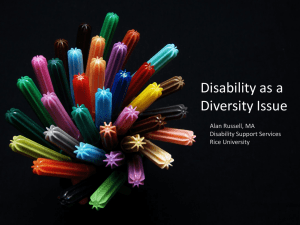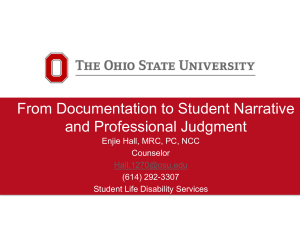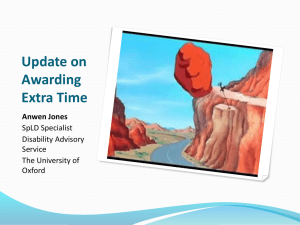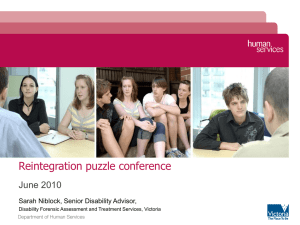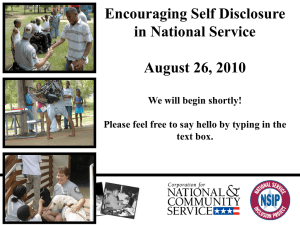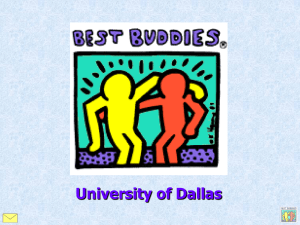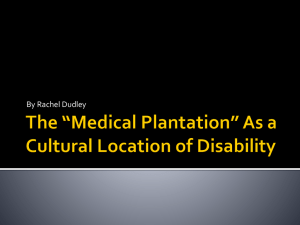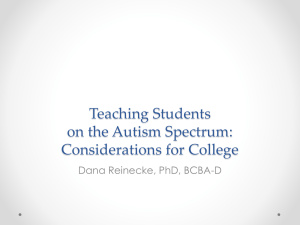Applications of Universal Design for Learning
advertisement
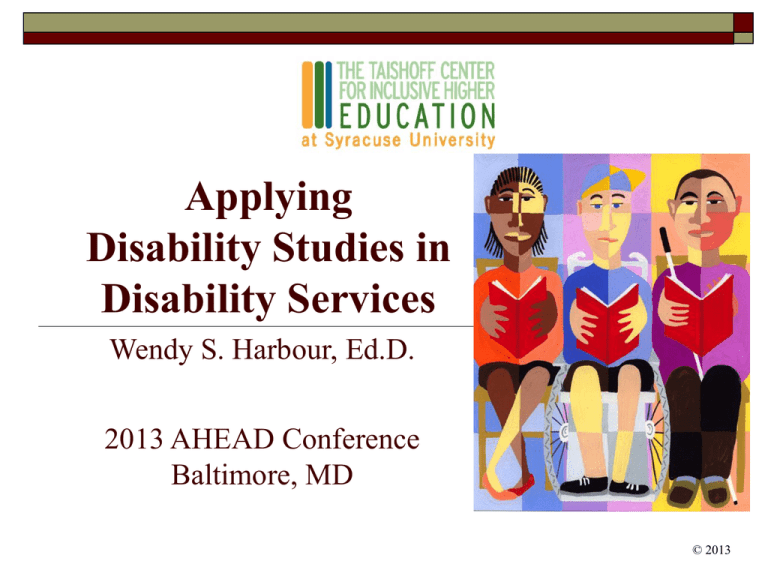
Applying Disability Studies in Disability Services Wendy S. Harbour, Ed.D. 2013 AHEAD Conference Baltimore, MD © 2013 Introductions and Overview PowerPoint and handout online Purpose of presentation: “Disability Studies 101” for disability services providers Models of disability Ableism Disability studies “Cripping” the curriculum: Infusing disability studies into courses Foundations of Disability Studies 1. Disability and disability-related barriers are socially constructed; disability does not have to be an inherently negative, pathological condition. 2. Ableism and oppression are part of the shared experience of disability. The Medical Model of Disability The Medical Model and Disability: It’s a problem with the person who has a disability Disabilities need to be fixed Professionals are the only hope for a cure or normality “Over-coming” and normality are goals Socio-Political Models of Disability The Social Model and Disability: Disability is neutral Barriers are “socially constructed” and primarily exist in the environment Disability is part of the human experience Anyone can create change Goal is to change environment to reduce barriers Socio-Political Models of Disability The Cultural Model and Disability: Disability defined by time, culture, ethnic group, etc. Disability is part of the human experience Attitudes about disability can teach us about our societies The goal is changing values and attitudes, and keeping “disability” in context Socio-Political Models of Disability The Political Model and Disability: Disability is defined by law, policy, and who has power or resources Political and legal definitions reflect trends in society The goal is distributing resources and re-defining concepts like “deserving” Summary of the Models Cultural Model Medical Model Society and Values Social Model Legal/Political Model Interactions and Environment Individual Law and Policy Models Reveal Ableism “…[T]he devaluation of disability results in societal attitudes that uncritically assert that it is better for a child to walk than roll, speak than sign, read print than read Braille, spell independently than use a spell-check, and hang out with nondisabled kids as opposed to other disabled kids, etc. In short, in the eyes of many educators and society, it is preferable for disabled students to do things in the same manner as nondisabled kids.” Hehir, T. (2002). Eliminating ableism in education. Harvard Educational Review, 72(1), 1-33. Connections… So how can we connect the Models of Disability and Ableism? Models of Disability Ableism The Traditional Models of Disability “Bad”/ “Good” Cultural Model Medical Model Social Model Legal/Political Model The Medical Model is viewed as “Bad” and ableist Other models dealing with the environment are seen as progressive, “Good” and empowering The Traditional Models of Disability “Bad”/ “Good” Cultural Model Medical Model Social Model Legal/Political Model What if all the models and aspects of disability can be “good” OR “bad”? Empowering or ableist? Examples: Ableism and the Models Medical Model Ableism Empowering Labels are used to define and segregate individuals Labels and impairments are viewed in context and may be empowering Social Model Ableism Focus on environment overlooks intrapersonal characteristics, creating oppression Empowering Environment is changed to reduce disability-related barriers Ableism and Disability Services Ways to apply the theory/models and address ableism: Universal Design Disability Studies Disability in Curriculum Universal Design in Education Designing the environment for the maximum diversity of learners Courses, Work, and Activities Services and Policy Architecture Technology Universal Design Choices & Flexibility Present information in different accessible formats Assume there will be a variety of users/learners Use different forms of evaluation or assessment so people can show what they have learned or understood Allow people to engage or be motivated in different ways Plan for possible access needs or services (e.g., physical accessibility, interpreters, braille) and ask whether these may work for everyone What is Disability Studies? Disability studies is a lens for thinking about the world. Disability Studies: Interdisciplinary Art History Identity Disability Studies: Interdisciplinary Deaf Studies Pop Culture Attitude and Activism Disability Studies: Attitude/Language http://vimeo.com/10023901 Disability Studies: Identity Having pride in oneself Finding a community Coming out as “disabled” Promoting disability as part of campus diversity No apologies for rights and accommodations – “independence” is what we do with supports and services (everyone is interdependent anyway) Beyond UD and Disability Studies: “Cripping” the Curriculum by Infusing Disability Avoids disability as just “Disability Awareness Days” or disability accommodations issue; disability becomes part of diversity Avoids potential erasure of disability happening with UD Examples: “Right to Die” in philosophy class Coding of “norms” in statistics Disability and the Holocaust in history Inclusion of authors with disabilities in English/literature courses; finding disability subtext or including disability in discussions of “difference” So What? Applying Critical Thinking AHEAD documentation guidelines Disability cultural centers and activist student groups “Disabilities,” “Conditions,” and “Temporary Disabilities” Questions about modifications Professionals as gatekeepers Faculty concerns about faking or special privileges Students who don’t want to use disability services Additional Resources Handout online Bibliography of resources: Disability studies in disability services, universal design, and first-person accounts of disability in higher education Q and A Contact information: Wendy S. Harbour, Ed.D. Taishoff Center, Syracuse University 805 South Crouse Avenue, 101 Hoople Building Syracuse, NY 13244-2280 Phone: 315-443-1288 or VideoPhone: 866-270-1281 wharbour@syr.edu
